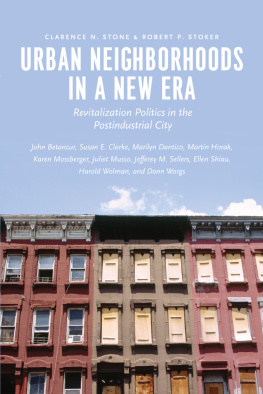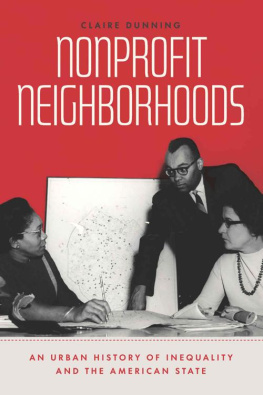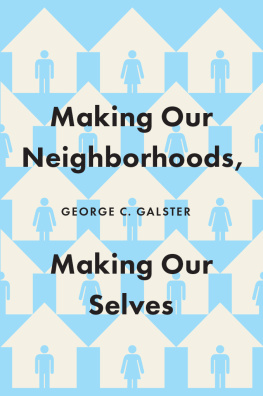Urban Neighborhoods in a New Era
Urban Neighborhoods in a New Era
Revitalization Politics in the Postindustrial City
Clarence N. Stone and Robert P. Stoker
John Betancur, Susan E. Clarke, Marilyn Dantico, Martin Horak, Karen Mossberger, Juliet Musso, Jefferey M. Sellers, Ellen Shiau, Harold Wolman, and Donn Worgs
The University of Chicago Press
Chicago & London
The University of Chicago Press, Chicago 60637
The University of Chicago Press, Ltd., London
2015 by The University of Chicago
All rights reserved. Published 2015.
Printed in the United States of America
24 23 22 21 20 19 18 17 16 15 1 2 3 4 5
ISBN-13: 9780-226288963 (cloth)
ISBN-13: 9780-226289014 (paper)
ISBN-13: 9780-226289151 (e-book)
DOI: 10.7208/chicago/9780226289151.001.0001
Library of Congress Cataloging-in-Publication Data
Stone, Clarence N. (Clarence Nathan), 1935 author.
Urban neighborhoods in a new era : revitalization politics in the postindustrial city / Clarence N. Stone and Robert P. Stoker [and 10 others].
pages cm
Includes bibliographical references and index.
ISBN 978-0-226-28896-3 (cloth : alk. paper) ISBN 978-0-226-28901-4 (pbk. : alk. paper) ISBN 978-0-226-28915-1 (ebook) 1. Neighborhoods United States. 2. Urban renewalUnited States. I. Stoker, Robert Phillip, 1954 author. II. Title.
HT123S7845 2015
307.3362160973dc23
2014047165
This paper meets the requirements of ANSI/NISO Z39.481992 (Permanence of Paper).
Contents
MARTIN HORAK, JULIET MUSSO, ELLEN SHIAU, ROBERT P. STOKER, AND CLARENCE N. STONE
HAROLD WOLMAN AND MARTIN HORAK, WITH THE ASSISTANCE OF CAMILLE A. SOLA AND DIANA HINCAPIE
ROBERT P. STOKER, CLARENCE N. STONE, AND DONN WORGS
JOHN BETANCUR, KAREN MOSSBERGER, AND YUE ZHANG
MARILYN DANTICO AND JAMES SVARA
ELLEN SHIAU, JULIET MUSSO, AND JEFFEREY M. SELLERS
SUSAN E. CLARKE
MARTIN HORAK AND AARON ALEXANDER MOORE
ROBERT P. STOKER, CLARENCE N. STONE, AND MARTIN HORAK
Metropolitan area manufacturing employment trends, 19802009 |
City manufacturing employment trends, 19802009 |
Central-city educational attainment |
City resident unemployment and labor force participation rates |
Global urban competitiveness rankings, 2011 |
City population, 19502010 |
City population as a percentage of metropolitan area population |
Racial composition, US cities and suburbs, 2010 |
Largest visible minority populations in Toronto, city and suburbs, 2011 |
Percentage of population that is foreign born |
Black-white segregation in US cities (racial dissimilarity indexes) |
City and suburban poverty rate |
Neighborhoods of concentrated poverty |
Comparing the redevelopment period and the new era |
My first venture into studying urban neighborhoods culminated in a book titled Economic Growth and Neighborhood Discontent (Stone 1976). It was about reshaping Atlanta from a rail-centered city to a place in a burgeoning automotive age. My Atlanta study was part of a wave of neighborhood studies, some looking internally to the features of urban neighborhoods, particularly those less well-off, and others paying special attention to the rise of neighborhood protests and, as in Atlanta, conflict between less prosperous neighborhoods and established power centers. The recurring narrative was about a largely localized neighborhood movement that scored scattered victories but was mainly positioned to wage occasional defensive battles with little capacity for affecting agendas over the long term.
In the years following World War II, the overarching consideration for city leaders, political and economic, was redevelopment. They saw remaking the central business district as their top priority. Other changes were under way, principally a black political mobilization, but city leaders had their policy eyes mainly on redevelopmentand through the federal highway and urban-renewal programs there was ample federal money to back this effort.
Whether labeled as such or not, many of these early works were studies of power. Notwithstanding the fact that nonaffluent neighborhoods did not lose all the battles, these studies described struggles between unequal contenders. The playing field was tilted heavily against less-well-off neighborhoods, and even when such neighborhoods survived, many came through this time bearing the marks of social and economic damage. Now we are in a different time, but scars from the past remain.
In contrast with accounts of the earlier era of redevelopment, this book identifies a basic shift through which relationships have become more fluid and policymaking more open-ended. Seen from a neighborhood perspective, new players, fresh issues, in some instances modified political-governmental arrangements, and a transformed context distinguish the present from earlier times. Whereas the postWorld War II years accorded economic development a privileged place, the current period allows for some mixing of economic-development aims with community-based concerns. The terms of this mix are negotiable, and the line between what favors economic development and what attends to community concerns has become increasingly fuzzy. Power is less and less a showdown between clearly differentiated antagonists and more a matter of how policy issues are framed, albeit accommodations are sometimes far from amicable.
Not to be overlooked is that poverty persists, neighborhood distress remains a highly visible feature of the urban landscape, and cities are at the center of contemporary inequality. Positive-sounding initiatives abound, but rarely do urban programs live up to the high expectations and incautious rhetoric that surround their launch. Still, historian Michael Katz (2011) questions the dominance in urban scholarship of what he terms the narrative of failure. He calls for a counternarrative while adding that the temptation to jettison the narrative of urban failure in favor of a story based on progress and hope must be resisted (2011, 159). In line with Katzs caution, the authors of this book see an array of incomplete steps and initiatives that have fallen short. But we also find significant accomplishments and many moves that make a difference to those who live in areas of disadvantage. While distressed neighborhoods seldom, if ever, get preferred treatment, they no longer suffer the nearly total disregard they once incurred.
Over time, understanding has grown that neighborhoods and their treatment are interwoven with other policies in the city: particularly transportation, order maintenance, and the pursuit of economic growth. There may have been a timeunder Model Cities, for instancewhen elite actors treated neighborhood policy as a differentiated arena to be operated separately and kept distinct from the economic-development agenda, but in the present era such policy thinking has largely faded away. Now neighborhood issues are often linked to broader city aims of growth and development, with public safety a continuing consideration as well.
Since this book identifies the emergence of a new era of neighborhood politics, perhaps not yet widely recognized, it seems in order to explain how the research unfolded and the theme for this book emerged. The present work grew out of an invitation from the Rockefeller Foundation to its Conference Center in Bellagio, Italy, to conduct a workshop on policy efforts to address distressed urban neighborhoods. The resulting Regenerating Urban Neighborhoods (RUN) project spawned by that workshop featured a two-part follow-up: a European wing and a North American wing. This book is a product of the latter, and it consists of six case studies covering Baltimore, Chicago, Denver, Los Angeles, and Phoenix in the United States and the Canadian city of Toronto. The six cities vary in size, but all are large and all are the central cities of metropolitan regions. They represent no sampling procedure but do cover a variety of political-governmental forms and socioeconomic conditions. The workshop chose to work from the ground up, with a focus on distressed neighborhoods as policy targets.






